SAMPEX (Solar Anomalous and Magnetospheric Particle Explorer)
EO
NASA
Mission complete
Quick facts
Overview
| Mission type | EO |
| Agency | NASA |
| Mission status | Mission complete |
| Launch date | 03 Jul 1992 |
| End of life date | 13 Nov 2012 |
SAMPEX (Solar Anomalous and Magnetospheric Particle Explorer)
SAMPEX (also known as Explorer 68) is NASA's first SMEX mission with the objectives to measure energetic electrons as well as ion composition of particle populations from about 0.4 MeV/nucleon to hundreds of MeV/ nucleon from a zenith-oriented satellite in near polar orbit; to study the energy, composition, and charge states of particles from supernova explosions, from the heart of solar flares, and from the depths of nearby interstellar space; also to monitor the magnetospheric particle populations which occasionally plunge into the middle atmosphere of the Earth. Mission design life = 1 year, with a goal of 3 or more years of operation. 1) 2)
SMEX (Small Explorer) is a NASA/GSFC satellite program (since 1989) with the objective to introduce innovative technologies into low-cost spacecraft design.
The design philosophy employs and end-to-end approach. Emphasis is placed on design simplicity (also a reduction of redundancies), functional independence at subsystem level, and flexibility to accommodate growth. The modular architecture applies to hardware, software, and to services of the system. Communication between subsystems flows via the MIL-STD-1553 data bus. The instruments and subsystems communicate with the computer using this bus. For instruments that produce high data rates, there are four EIA RS422 Direct Memory Access (DMA) interfaces to the computer memory.
A SMEX spacecraft consists of a one-piece cast aluminum structure (a thermally conductive composite S/C structure). The following on-board technologies are employed: the computer is a single-board 80386/80387 RISC processor (Loral RAD-6000 32-bit) featuring dynamic memory management; fiber-optic data bus; GaAs solar arrays (modular); high-density solid-state recorder; high torque reaction wheels, and NiCd batteries. Attitude sensors: coarse sun and fine sun sensors, star tracker, magnetometer (3-axis fluxgate), gyroscopes. Actuators: magnetic torquers and reaction wheels. S/C communications: RF transmitters with 4 Mbit/s X-band downlink, QPSK modulation and 3.5 W RF power; RF receivers with 4 kbit/s S-band uplink, BPSK modulated directly on the S-band carrier with Bi-phase L capability. All communications (format, procedure, etc) are in CCSDS standard. S/C baseline configuration: minimum operational lifetime of one year, S/C mass of 75 kg plus up to 225 kg of payload mass, power = 150-400 W for payload use.
SAMPEX was the first spacecraft globally using a fiber-optic data bus and to utilize the first FPGA. 4)
The NASA SMEX missions include the following S/C: SAMPEX, FAST (Fast Auroral Snapshot Explorer) and SWAS (Submillimeter Wave Astronomy Satellite), TRACE (Transition Region and Coronal Explorer) and WIRE (Wide-Field Infrared Explorer).
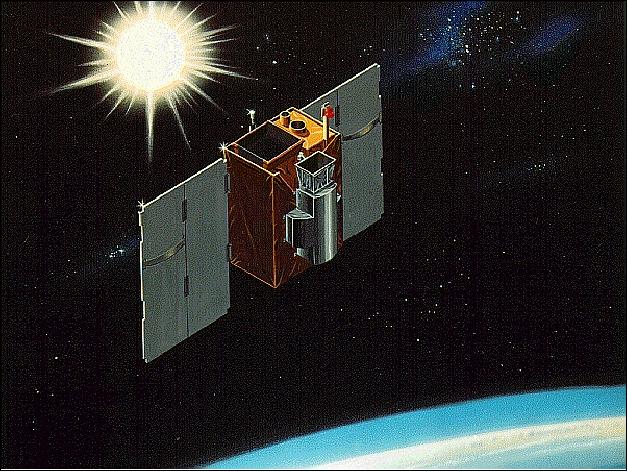
Spacecraft
The spacecraft, designed and developed at NASA/GSFC, consists of the primary structure, instrument support structure, isobutane tank, deployable solar arrays, and the yo-yo despin mechanism. The SAMPEX bus structure contains most of the subsystem components and provides the interface to the Scout 200-E adapter on the fourth stage of the Scout launch vehicle. SAMPEX is a momentum-biased, a sun-pointed S/C that maintains the experiment view-axis in a zenith direction. It points its solar arrays at the sun by aiming the momentum vector toward the sun and rotating the S/C one revolution per orbit about the sun/spacecraft axis. 5)
ACS (Attitude Control System): The ACS is designed as a solar pointed/momentum biased system using the momentum wheel to orient the experiment viewing axis about the sun vector. The sensor and actuator complement consists of one FSS (Fine Sun Sensor), five CSS (Coarse Sun Sensors), and magnetometer, three torque Rods, and one momentum wheel.
The spacecraft pitch axis is kept within 5º of sun line at all times. The spacecraft yaw axis (experiment boresight) should approach the zenith (local vertical) vector in the polar regions during science operations. The spacecraft yaw axis is maintained at an angle greater than 45º from the spacecraft velocity vector during science operations. Ground reconstruction of the spacecraft attitude is required to be less than 2º.
An ACE (Attitude Control Electronics) box which contains signal conditioning electronics and an independent analog safehold mode completes the ACS hardware manifest. SEDS performs closed loop real-time attitude determination and control processing. Three-axis attitude determination is provided by comparing the local measured sun vector and magnetic field vector with an on-board ephemeris model. Digital control of the spacecraft attitude is completed by sending appropriate command signals across the spacecraft data bus to the actuators.
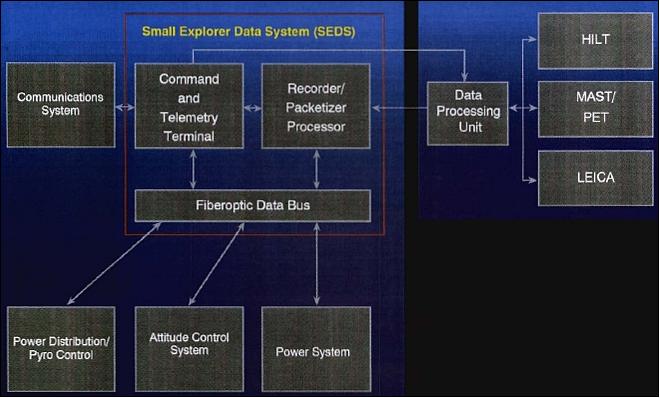
EPS (Electrical Power Subsystem): The on-orbit average output power of the system is 102 W using a GaAs (Gallium Arsenide) solar array with no shadowing and minimum solar intensity at end of minimum mission life (3 years). The two solar arrays have a size of 1.7 m2. One 9 Ah NiCd battery is used.
The function of the PD/PCU (Power Distribution/Pyro Control Unit) is to provide primary power distribution and fusing to other spacecraft subsystems, and the control and power to spacecraft's separation and deployment pyrotechnic devices. The EPS power is received over the three power busses: essential, non-essential, and pyrotechnic. The PD/PCU distributes the power to the subsystems through appropriate relay and fuse circuits.
The PD/PCU electronics provides for receipt of power relay commands from the SEDS (Small Explorer Data System), monitoring of relay status, collection of internal housekeeping data, primary current sensing, and signal conditioning for the CTT, RPP, ACE, and transponder. The PD/PCU receives commands and transmits data via the MIL-STD-1773B data bus.
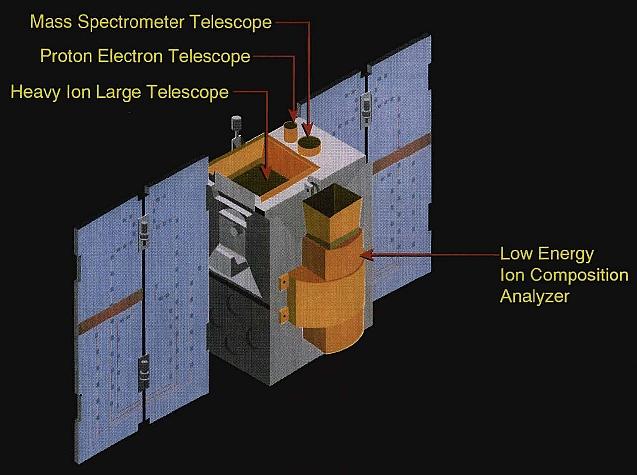
SEDS (Small Explorer Data System)
SEDS utilizes NASA's first MIL-STD-1773 Fiber Optic Multiplexed Data Bus (or 1773 bus) to communicate with the other spacecraft subsystems in the space environment. The 1773 bus is the fiber optic version of the MIL-STD-1553 Data Bus, an electronic wire bus used in many avionics applications. Due to the successes based on ground radiation test results and the spaceflight SEU data, the 1773 bus has been baselined for several additional NASA missions [XTE ((X-ray Timing Explorer), TRMM (Tropical Rainfall Measuring Mission), FUSE (Far Ultraviolet Spectroscopic Explorer), et a1 ...] as well as generating great interest in the DoD community (Ref. 4). 6)
Fiber optics provides a significantly reduced weight and power solution to spacecraft subsystem interfacing, while providing EMI/RFI immunity to the cable harness. The 1773 bus is a master/slave, 1 MHz bandwidth means of passing telemetry and commands between spacecraft subsystems. The 1773 bus has enhanced reliability due to its use of redundant busses (i.e., A and B sides). The 1773 bus transfers messages of up to 32 words between subsystems encoded with Manchester coding (i.e., each bit has a mid-bit transition). The receiving subsystem responds with a short status packet to tell the system controller whether or not the transfer was successful. This data transfer includes parity and other error checking means to control the error flow. Additionally, if an error occurs, the 1773 bus has the option of automatically retrying the same data transfer (an entire data packet of up to 640 bit) that failed either on the side that failed or the redundant side, thus reducing the effective error rate. The number of optional bus retries is set by the system designer.
Each subsystem contains a 1773 optical terminal consisting of two of each of the following: Honeywell HFD3801-002 TTL Integrated Fiber Optic Receiver (Si PIN diode and bipolar IC), Honeywell HFE4811-014 TTL Integrated Fiber Optic Transmitter (GaAlAs LED and bipolar IC), and a radiationhardened ASIC from LSI Logic. The optical terminal provides the interface between the user's electronics and the optical fiber bus utilizing a 850 nm wavelength (Ref. 6).
SEDS is comprised of a RPP (Recorder, Processor,Packetizer) and a CTT (Command and Telemetry Terminal). SEDS provides on-board computers that can be programmed to perform mission unique functions as required and provides autonomous operation of the spacecraft when it is not in contact with the ground. It controls the spacecraft attitude and provides primary command and control of experiments and spacecraft subsystems, and interfaces with the spacecraft communications system (Figures 4 and 7).
SEDS collects data from the different subsystems and instruments, stores the data, processes it, and sends it to the ground using recognized packet telemetry standards. The data system uses solid-state memory to record spacecraft telemetry data when the spacecraft is out of contact with the ground.
• The RPP provides storage for 26.5 MByte, packetizes commands and telemetry and is used as a general purpose processor. The RPP supports general spacecraft control functions and specific control functions such as attitude control. For general spacecraft control, the RPP monitors data to determine the general status of the spacecraft, instruments and the data system. The RPP checks critical parameters to determine if limit conditions have been exceeded. If they have, the RPP executes predefined stored command sequences. Working in conjunctions with safehold mechanisms, the RPP periodically performs a variety of self tests and reports its status to watchdog systems such as attitude control safehold system.
• The CTT is a remote terminal that has been configured to connect the transponder to the rest of the data system. The CTT provides the following functions:
- Uplink command processing
- Downlink telemetry encoding
- Spacecraft time management
- Local telemetry acquisition and command distribution
- System monitoring.
The CTT provides processing for commands and telemetry and can acquire control of the spacecraft if the RPP fails. CTT supports low rate (<100 kbit/s) communication requirements of instrument; provides telemetry data acquisition; provides command output distribution; and provides debug interfaces for integration and test (I&T) support.
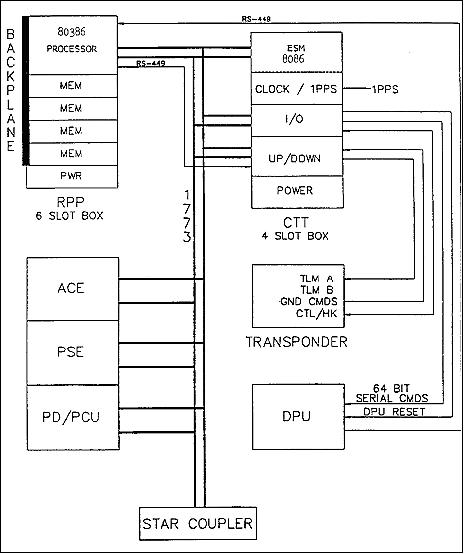
RF communications: The antenna system is composed of two quadrifilar helices, two 90º hybrid junctions, and a power divider. These omnidirectional antennas are located on the top of the spacecraft and on the bottom of a solar panel. The top antenna is a half-turn quadrifilar with a 150º beamwidth. The bottom antenna is a three-turn quadrifilar with a 210º beamwidth (in this context, the beamwidth is defined as that view sector of a principle plane where the gain meets or exceeds -5 dBi as required). Each antenna is fed with a 90º hybrid junction to create the proper phasing between elements. A power divider feeds each hybrid junction to create the proper phasing between elements. A power divider feeds each hybrid junction with a single of equal amplitude and phase. This system is designed to operate in S-band over a 2025-2300 MHz frequency range.
An S-band transponder, operating in full duplex mode, provides the reception of uplinked commands, transmission of telemetry data and support of the Doppler tracking by the designated ground station. The received uplink is transmitted as NRZ (Non-Return to Zero) bi-phase modulated synchronously on a 16 kHz subcarrier. The command data rate is 2 kbit/s. The telemetry output signal is modulated on the transmitter to produce the downlink signal. The transmitter modulation bandwidth is 3 MHz and its output power is 5 W. The S-band transponder interfaces with the S-band antenna and the SEDS CTT.
The SAMPEX mission was the first spacecraft mission in the USA to implement the CCSDS (Consultative Committee for Space Data Systems) communication standards.
Spacecraft structure | Aluminum semi-monocoque assembly |
ACS (Attitude Control System) | - Sun/zenith pointed spacecraft, later introduction of pointing mode to orient the instrument boresights perpendicular to the field lines of the geomagnetic field. |
EPS (Electrical Power System) | - Solar arrays: GaAs solar cells, 2 deployed panels of size 1.7 m2 (total) |
OBC (On-board Computer) | 80386/80387 processor, 30 MByte solid state recorder, MIL-STD-1773 fiberoptic data bus |
RF communications | S-band transponder, 2 kbit/s uplink, 900 kbit/s downlink |
Instrument mass, power | 40 kg, 22 W |
Spacecraft mass | 157 kg, |
The payload mass is 40 kg, the total S/C mass is 157 kg (aluminum structure, passive thermal control). The solid-state recorder has a capacity of 30 MByte. On-board fiber optic data bus (MIL-STD-1773B). The S/C features two omni antennas and a near-Earth 5 W S-band transponder.
Launch
The SAMPEX minisatellite was launched on July 3, 1992 from the Western Test Range/VAFB (Vandenberg Air Force Base), CA, using a Scout launch vehicle.
Orbit: Near-polar orbit, perigee = 520 km, apogee = 670 km, inclination = 82º, period = 96.7 minutes.
Mission Status
• The SAMPEX spacecraft reentered Earth's atmosphere on November 13, 2012 after 20 years of service. Over its lifetime, SAMPEX provided for the first time a continuous record of high sensitivity measurements of energetic ions and relativistic electrons over almost two solar cycles. These data resulted in new insights into the acceleration, transport and loss processes in the Earth’s magnetosphere, driven by high speed streams or coronal mass ejections in the solar wind.
SAMPEX also discovered doubly charged anomalous cosmic rays of interstellar origin (N, O, Ne), thus limiting the time scale for acceleration of these ions in the outer heliosphere to a few years. The measurements also confirmed the existence of the trapped component of these anomalous cosmic rays and showed that this is located in a narrow belt within the inner region of the Van Allen radiation belts. Furthermore, the SAMPEX mission also successfully addressed important scientific objectives concerning solar energetic particles - when SAMPEX launched, the sun was just finishing the peak of its 11-year solar cycle and beginning to move toward solar minimum. 8) 9)
The science mission was originally intended to last three years, but the spacecraft continued to operate until the very end. In 2004, the science mission officially ended, but the spacecraft was still in very good condition so that data acquisition was still possible. SAMPEX continued to take data and downlink it to Earth thanks to funding by The Aerospace Corporation of El Segundo, CA. The satellite was operated by Bowie State University that used it as an educational tool for its students.
Towards the end of its mission, SAMPEX became important again as the next generation of Radiation Belt Probes were launched into Orbit. The two Van Allen Probes, also called RBSP (Radiation Belt Storm Probes), started science operations after being launched on August 30, 2012. With the imminent demise of SAMPEX, the RBSP mission was changed and the REPT (Relativistic Electron Proton Telescope) instrument of the two spacecraft was activated much earlier than planned to gather data in parallel with the HILT (Heavy Ion Large area proportional counter Telescope) on SAMPEX. 10)
• In November 2012, the spacecraft's orbit will decay enough that it will re-enter Earth's atmosphere, burning up completely on reentry. 11)
• The SAMPEX mission has provided a long-term global picture of the radiation belts and has revealed the Van Allen radiation belts to be far more dynamic and complex than originally thought. SAMPEX measures anomalous and galactic cosmic rays, using Earth’s magnetic field as a mass spectrometer - to separate different energies and charge states of particles as SAMPEX executes its near polar orbit. SAMPEX also provided images of Earth’s ring current in energetic neutral atoms. In addition to the scientific interest, energetic particles are also an important element of space weather: they must be understood so that they their occurrence can be reliably forecast. - Long-term and continuous measurements of the solar wind and magnetosphere are valuable and critically important for understanding physical processes during different parts of the solar cycle. 12)
• In 2010, the SAMPEX mission is still in operation after 18 years in orbit. 13)
• In June 2007, the Senior Review Panel recommended an extension of the mission and that the SAMPEX mission play an active role in the Interdisciplinary Investigation Program. The Panel specifically recommends a test of the effectiveness of a SAMPEX-based early-warning system for Space Station astronauts. 14)
• In 2004, after a 1-year prime mission phase and > 10 years of extended operations, the SAMPEX team made numerous contributions to our understanding of the energetic particle environment in the vicinity of Earth, in particular the ionization states, energy spectra, and isotopic composition of galactic rays, anomalous cosmic rays, and solar energetic particle events, the acceleration mechanisms for relativistic magnetospheric electrons and protons, and the effects of precipitating electrons on middle atmospheric NOy. Although the Office of Space Science Senior Review held in 2003 recommended that SAMPEX science and instrument operations terminate on June 30, 2004, NASA will continue to track the spacecraft as part of an engineering test.
• 2004: ACS (Attitude Control System) operated in 3 modes over the course of the mission:
1) ORR (Orbit Rate Rotation). ORR was in use during roughly the first 2 years of the mission. The ORR mode algorithm was designed to optimize the following requirements:
- Spacecraft solar panels always facing the sun
- Avoidance of pointing instruments into the RAM direction
- Pointing as close to the local zenith as possible.
2) MORR (Modified Orbit Rate Rotation). MORR was used after the first 2 years, interspersed with periods with SPIN mode. Requirements were the same as for the ORR mode with the additional requirement:
- Instruments will point perpendicular to the local magnetic field when its strength is < 0.3 Gauss, and will point along the local magnetic field in the direction nearest the zenith elsewhere.
This additional science requirement was implemented after the discovery of trapped Anomalous Cosmic Ray Oxygen, especially in the region of the South Atlantic Anomaly (SAA). The pointing requirement has the result of looking at the trapped population when the spacecraft was in the SAA.
3) SPIN mode: In spin mode the spacecraft rotates about the y (sun pointing) axis once per minute. This mode was introduced in 1996, and was in place through mid 1998, and occasionally afterwards. The science requirement was to give broad pitch angle coverage, especially for magnetospheric particles. RAM avoidance was not a requirement in this mode since by the time it was introduced the HILT proportional counter gas was exhausted.
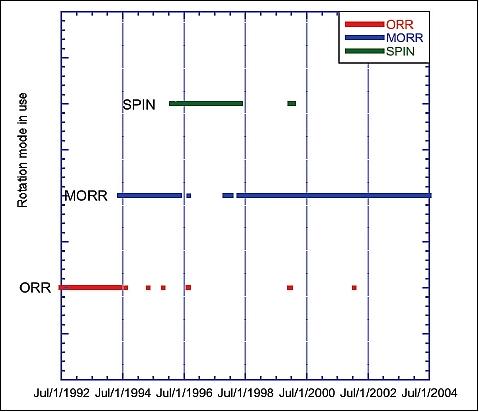
• In January 2004, BSOCC received flight control permission of the NASA WIRE (Wide-field Infrared Explorer) mission in parallel to the SAMPEX mission. Tasks executed by the space flight team members include: building command loads to the satellite during real-time contacts, managing the onboard data recorder, overseeing schedules of ground contacts with the spacecraft, configuring the BSOCC ground system and initiating the set-up of the NASA ground network.
• In late October and early November 2003, the SAMPEX instruments reported observations of the response of the low-altitude radiation population below L = 3 during and after the strong solar energetic particle events and geomagnetic disturbances. Due to these events, the usual belt of energetic protons (above 19 MeV) around L = 2 almost completely disappeared, recovering only after several months. Also observed was the appearance of a new belt of ultrarelativistic (above 10 MeV) electrons centered around L = 2. 15) 16)

• As of the end of 1997 SAMPEX is fully operational.
• In October 1997, NASA/GSFC handed mission control over to BSOCC (Bowie State University Satellite Operation Control Center). BSOCC is located just about 10 miles northeast of the GSFC. The venture, also supported by Honeywell Technology Solutions, Inc., provides training opportunities for new scientists and engineers in astrophysics and space physics. 17)
• The SAMPEX mission was planned with a three year life-cycle, plus a possible one year extension. On July 1, 1995 SAMPEX entered its extended operations phase. Shortly after this milestone, discussions began concerning the establishment of a SAMPEX Flight Operations Facility on a university campus. Bowie State University (BSU) in Maryland was selected as the recipient of the first satellite operations facility constructed by NASA's GSFC on a university campus. 18)
Sensor Complement
The four SAMPEX scientific sensors each address a subset of the required measurements with enough overlap in energy range and response to allow intercalibration and partial redundancy (Figure 7). The four instruments are serviced by a common DPU (Data Processing Unit), provided by The Aerospace Corporation.
The DPU philosophy for SAMPEX was to provide a single data interface with the SEDS (Small Explorer Data System). Spacecraft housekeeping data is sampled through a Mil-Std-1773B fiber optic data bus. A 1 Hz timing pulse is sent to the ACE (Attitude Control Electronics) box and the DPU, providing a fiducial from which the exact timing of each second is obtained.
Data received by the DPU from all instruments are similar in type, however, the controls and timing necessary to read data differs between the instruments based on their dissimilar heritages. All ground commands, whether destined for the DPU or one of the instruments, are passed through the DPÜ where the command checksum can be verified prior to actual command execution.
The DPU hardware design makes extensive use of FPGAs (Field Programmable Gate Arrays) of Actel to implement the modular hardware system (Figure 8). The FPGAs are attractive for satellite instrumentation since each chip provides ~2000 logic gates in a quad flatpack package of size 2.2 cm2. The power dissipation for an Actel component depends on many factors, but for the SAMPEX DPU, where a total of 12 FPGAs are used, the average power dissipation is 102.5 mW.
The DPU's spacecraft interface (including command, telemetry, and time distribution interfaces) is implemented within the DPU using a single Actel FPGA. Spacecraft interface redundancy is achieved by collocating two copies of the spacecraft interface chip on the same interface board. The best of the two spacecraft interfaces is chosen during the DPU's power on diagnostics where the SEDS provides an echo feature to help with the selection process.
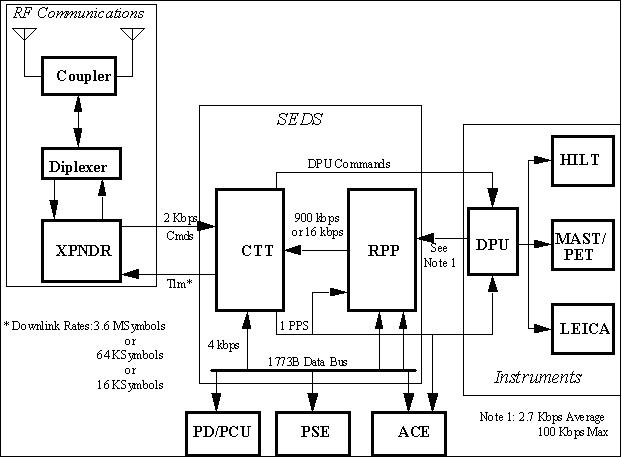
The earliest application of FPGAs flown in space were installed in the DPU (Data Processing Unit) of the SAMPEX spacecraft, the first spacecraft in the NASA/GSFC (Goddard Space Flight Center) Small Explorer (SMEX) program. 19)
Six A1020-CQ84B, data code 9113 were used in the DPU design for parallel processing, fault tolerance, and redundancy. The A1020 was built on a Matsushita Electric Corp. (MEC) 2.0 µm process and contained 547 logic cells, each of which contained essentially a 4:1 multiplexer and OR gate. The DPU was an 80C85RH-based system (Harris microprocessor) with 24 kbytes of PROM and 56 kbytes or RAM.
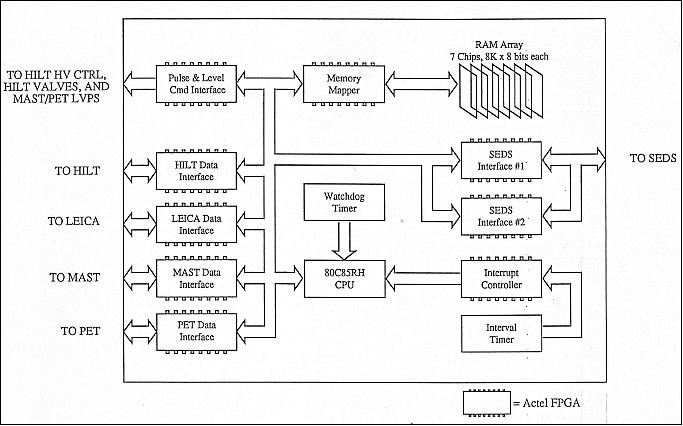
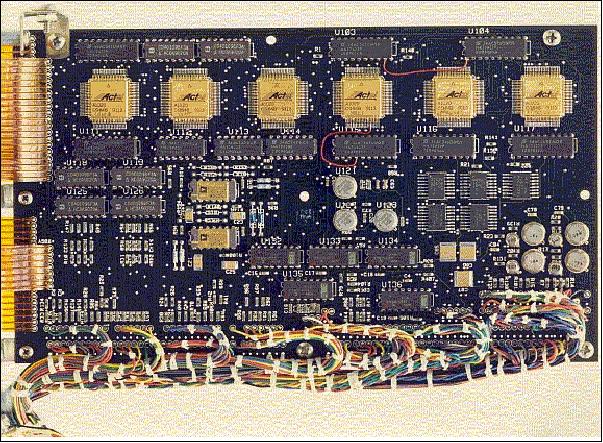
LEICA (Low-Energy Ion Composition Analyzer)
The instrument is also referred to as LICA. Instrument mass = 7.4 kg, power = 4.9 W, data rate = 1.3 kbit/s FOV (Field of View) = 17º x 21º. PI: Glenn Mason. Objective: to measure 0.5 - 5 MeV/nucleon solar and magnetospheric ions (He through Ni) arriving from the zenith in twelve energy bands (Ref. 2). 20)
LICA is a time-of-flight spectrometer that monitors incident ion mass and energy by simultaneously measuring the time-of-flight and the kinetic residual energy of particles that enter the telescope and stop in an array of four solid-state detectors. The time-of-flight is determined by start and stop pulses from chevron microchannel plate (MCP) assemblies that detect secondary electrons emitted from the entrance foil and a foil in front of the solid state detector, respectively, when the ion passes through them. These secondary electrons are accelerated to approximately 1 kV and deflected onto the MCPs by electrostatic mirrors. The measured energy and velocity are combined to yield the mass of the ion and the energy per nucleon.
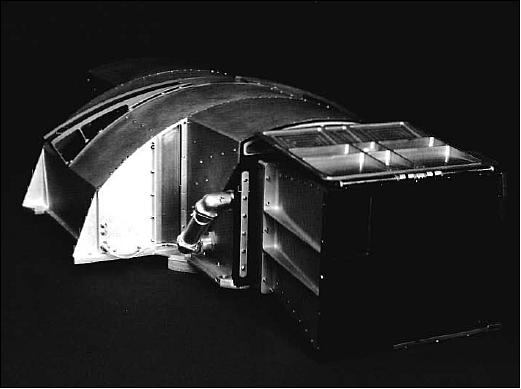
HILT (Heavy Ion Large Telescope)
HILT is a collaborative instrument of the MPE (Max Planck Institut für Extraterrestrische Physik), Garching, Germany and The Aerospace Corporation, El Segundo, CA, USA. PI: Berndt Klecker. Instrument mass = 22.8 kg, power =5.7 W, data rate = 0.9 kbit/s.
Objectives: to measure the charge, energy, and mass of cosmic rays in the energy range of about 8.0 - 310 MeV/nucleon. Specifically, the energy ranges were: He: 3.9 - 90 MeV/nucleon; C: 7.2 - 160 MeV/nucleon; O: 8.3 - 310 MeV/nucleon; Ne: 9.1 - 250 MeV/nucleon; and Fe :11 - 90 Mev/nucleon. The instrument consists of a three-element ion drift chamber with two thin multilayer entrance windows followed by an array of 16 solid-state detectors and a scintillation counter with photodiodes. HILT uses a flow-through isobutane system for the drift chamber. 21)
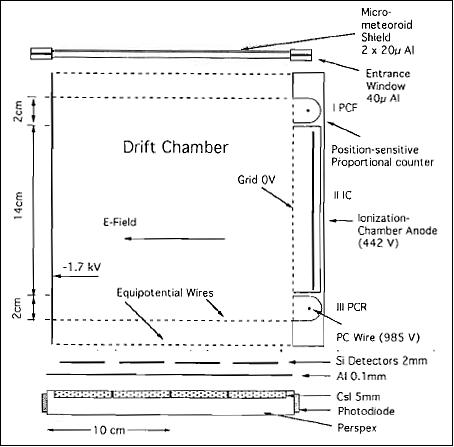
MAST (Mass Spectrometer Telescope)
PI: Richard Mewaldt, Caltech. Instrument mass = 7.5 kg, power = 3.3 W, bit rate = 1.4 kbit/s. MAST monitors the isotopic composition of elements from Li (Z=3) to Ni (Z=28) in the rang of about 10 MeV/nucleon - several hundred MeV/nucleon. MAST consists of a combination of surface barrier and lithium-drifted solid-state detectors (11 total). Combined matrix detector positions determine the particle trajectories, allowing accurate corrections to be made for the path length variation with angle and detector response for nonuniformities. MAST also performs measurements of stopping He isotopes from about 7 - 20 MeV/nucleon. 22)

PET (Proton/Electron Telescope)
(Caltech/GSFC). Instrument mass = 7.5 kg, power = 1.2 W, bit rate = 0.5 kbit/s. PET complements MAST by monitoring the energy spectra and relative composition of protons (18 - 250 MeV) and helium nuclei (18 - 350 MeV/nuclei) of solar, interplanetary, and galactic origins, and the energy spectra of solar flare and precipitating electrons from about 0.4 to about 30 MeV. The instrument measures both trapped and precipitating energetic particles in different parts of the SAMPEX orbit.
Data: On-board data storage is provided by solid-state memory (26.5 Mbyte of data storage). Data transmitted to the ground is formatted as a “Packet Telemetry” stream in accordance with CCSDS standards. S/C operation by GSFC on a continuous basis. Data are transmitted to the ground twice per day via the Wallops Flight Facility. 23)
Energy Range for: | LEICA | HILT | MAST | PET |
Electrons | - | - | - | 0.4-30 MeV |
H | 0.76 - 6.1 | - | - | 18 - 250 MeV |
He | 0.45 - 6.1 | 4.3 - 38 | 7 - 20 | 18 - 350 MeV/n |
C | 0.44 - 11.4 | 7.2 - 160 | 14 - 210 | 34 - 120 MeV/n |
Si | 0.33 - 5.5 | 9.6 - 177 | 21 - 330 | 54 - 195 MeV/n |
Fe | 0.21 - 3.1 | 11 - 90 | 27 - 450 | 70 - 270 MeV/n |
Charge range for elements | 1 - 26 | 2 - 28 | 2 - 28 | 1 - 2 (1 -28*) |
Charge range for isotopes | 2 - 16 | 2 | 2 - 28 | 1 - 2 (1 - 10*) |
Geometry factor (cm2 sr) | 0.8 | 60 | 7 - 14 | 0.3 - 1.6 |
FOV (º, full angle) | 24 x 20 | 68 x 68 | 101 | 58 |
Mass (kg) | 7.4 | 22.8 | 8.8 | (incl. with MAST) |
Power (W) | 4.9 | 5.6 | 5.3 | (incl. with MAST) |
Telemetry (kbit/s) | 1.3 | 0.9 | 1.4 | 0.5 |
* commandable low-gain mode | ||||
Ground Segment
The SAMPEX data are played back twice per day at the Wallops Island Orbital Tracking Station. The WFF (Wallops Flight Facility) transfers the data stream to the GSFC (Goddard Space Flight Center). The PACOR (Packet Processor) interfaces with the ground station via NASCOM, and records all incoming data. All data transfers to PACOR occur during real-time contacts with the spacecraft or by playback from the ground station (Ref. 5).
The University of Maryland. operates the UMSOC (University of Maryland Science Operation Center). The UMSOC is the primary science data distribution center for SAMPEX. Figure 13 illustrates the operational data flow of the SAMPEX mission. The SAMPEX data transmission system includes a space segment and a ground segment.
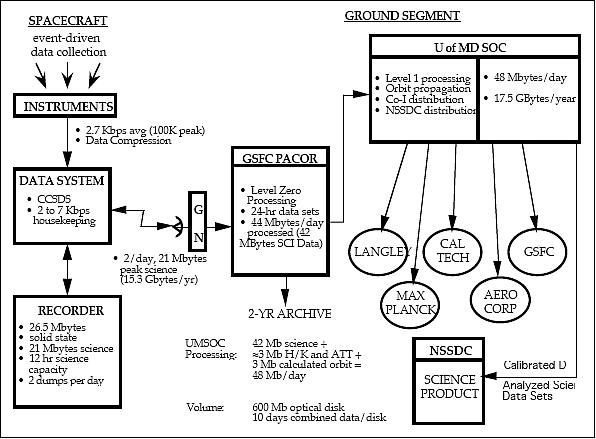
The SAMPEX ground segment elements directly involved in the transmission and processing of science data are the ground stations, the POCC (Payload Operations and Control Center) at GSFC, PACOR and the UMSOC.

SAMPEX Mission Operations
One of the core technologies being demonstrated in the SMEX Mission Operations Center (MOC) is the GMSEC (GSFC Mission Services Evolution Center) architecture. The GMSEC architecture uses commercial Message Oriented Middleware with a common messaging standard to realize a higher level of component interoperability, allowing for interchangeable components in ground systems. Moreover, automation technologies utilizing the GMSEC architecture are being evaluated and implemented to provide extended lights-out operations. This mode of operation will provide routine monitoring and control of the heterogeneous spacecraft fleet. The operational concepts being developed will reduce the need for staffed contacts and is seen as a necessity for fleet management. 24)
When the SAMPEX mission entered into the extended mission operations phase, the FOT (Flight Operations Team) at GSFC was challenged to continue support for the mission on a reduced budget. Although the SMEX missions (SAMPEX, SWAS, TRACE and WIRE) were all located in the same facility, each mission featured individual software and hardware systems for mission operations at GSFC.
SAMPEX, being the oldest SMEX satellite, has a different on-board architecture than the other missions, which affects the MOC. This forces the MOC, for example, to deal with a SAMPEX-unique mnemonic naming convention.
The GMSEC architecture allows missions to defer their component selection, since the integration and interfaces are already defined. GMSEC also provides the missions with an evolution path to cope with hardware and software obsolescence. Components can quickly be configured to run in parallel, allowing verification and testing of the new system before switching full operations to that system. This is an important characteristic when dealing with missions which have exceeded their life expectancy by over a decade.
Since three of the SMEX missions (SAMPEX, WIRE, TRACE) are extended-life ‘engineering’ missions, they are now being used to demonstrate heterogeneous mission operations performed on a single MMOC (Multi-Mission Operations Center). The primary motivator for this path-finding expedition is to demonstrate and exercise fleet control and concepts for future missions while revealing costs savings that could be realized with this type of consolidated architecture. The secondary motive was to demonstrate several new ground system architecture technologies with operational missions.

Developing the MMOC at GSFC proved that many of the GMSEC concepts of building a middleware-based satellite ground system supporting multiple satellites were possible.
The Bowie State Satellite Operations and Control Center (BSOCC) program is a partnership between BSU (Bowie State University) and NASA/GSFC which started in the mid-1990s. Located on the campus of BSU in suburban Washington, D.C., BSOCC has been training students in real-time satellite flight operations since 1996. This innovative program combines a rigorous series of mission control certifications with daily flight operations for NASA’s SAMPEX mission (Ref. 13).
In the meantime, the BSOCC is providing mission operations for two SMEX missions:
• In October 1997, NASA/GSFC handed the SAMPEX mission control over to BSOCC
• In January 2004, BSOCC received flight control permission of the NASA WIRE (Wide-field Infrared Explorer) mission in parallel to the SAMPEX mission.
References
1) D. N. Baker, G. M. Mason, O. Figueroa, G. Colon, J. G. Watzin, R. M. Aleman, “The Solar, Anomalous, and Magnetospheric Particle Explorer (SAMPEX) Mission,” Preprint 93-128, U. of Maryland - see also (by the same authors): IEEE Transactions on Geoscience and Remote Sensing, Vol. 31, No. 3, May 1993, pp. 531-541
2) http://lasp.colorado.edu/sampex/sampex.html
3) J. G. Watzin, “SMEX-LITE: NASA's Next Generation Small Explorer,” Proceedings of the 10th Annual AIAA/USU Conference on Small Satellites, Logan, UT, Sept. 16-19, 1996
4) Kenneth A. LaBel, Cheryl J. Marshall, Paul W. Marshall, Philip J. Luers, Robert A. Reed, Melanie N. Ott, Christina M. Seidleck, Dennis J. Andrucyk, “On the Suitability of Fiber Optic Data Links in the Space Radiation Environment: A Historical and Scaling Technology Perspective,” Proceedings of the IEEE Aerospace Conference, Snowmass at Aspen, CO, March 21-28, 1998, URL: http://nepp.nasa.gov/docuploads/9445E4C8-52DF-466F-89038759A6D7F08E/ieeeaero.pdf
5) Richard Hollenhorst, Daniel Baker, Glenn Mason, George Withbroe, Joseph King, “Small Explorer (SMEX) Project Data Management Plan (PDMP) for Solar Anomalous and Magnetospheric Particle Explorer /SAMPEX), NASA/GSFC, March 28, 1994
6) Kenneth A. LaBel, Paul Marshall, Cheryl Dale, Christina M. Crabtree, E. G. Stassinopoulos, Jay T. Miller, Michele M. Gates, “SEDS MIL-STD-1773 Fiber Optic Data Bus: Proton Irradiation Test Results and Spaceflight SEU Data,” IEEE Transactions on Nuclear Science, Vol. 40, No 6, Dec. 6, 1993, pp. 1638-1644, URL : http://radhome.gsfc.nasa.gov/radhome/papers/tns1993_LaBel.pdf
7) F. Landis Markley, Thomas W. Flatley, Theodore Leoutsakos, “SAMPEX Special Pointing Mode,” 1995, URL: http://ntrs.nasa.gov/archive/nasa/casi.ntrs.nasa.gov/19950021359_1995121359.pdf
8) Hannelore Hämmerle, Berndt Klecker, “SAMPEX Re-Entry into the Atmosphere,” MPE, Nov. 15, 2012, URL: http://www.mpe.mpg.de/991368/News_20121115
9) “SAMPEX Mission Returns to Earth,” The Aerospace Corporation, Nov. 21, 2012, URL: http://www.aerospace.org/2012/11/21/sampex-mission-returns-to-earth/
10) “SAMPEX Re-Enters Earth's Atmosphere after 20 Years of Service,” Spaceflight 101, Nov. 13, 2012, URL: http://www.spaceflight101.com/re-entry-november-2012.html
11) Karen C. Fox, “NASA's SAMPEX Mission: A Space Weather Warrior,” NASA/GSFC, Nov. 01,2012, URL: http://www.nasa.gov/mission_pages/sunearth/news/sampex-deorbit.html
12) Xinlin Li, D. N. Baker, S. G. Kanekal, M. Looper, M. Temerin, “Long Term Measurements of Radiation Belts by SAMPEX and Their Variations,” Geophysical Research Letters, Vol. 0, No 0, 2001, URL: http://lasp.colorado.edu/~lix/paper/GRL/grl01.SAMPEX.pdf
13) Leigh Gatto, Todd Watson, “Classes and Spacecraft Operations,” NASA ASK (Academy Sharing Knowledge) Magazine, Issue 37, Winter 2010, URL: http://askmagazine.nasa.gov/pdf/pdf37/NASA_APPEL_ASK_37s_classes_spacecraft_operations.pdf
14) Gerald Atkinson, William J. Burke, Lennard A. Fisk, John W. Harvey, Janet G. Luhmann, Eugene N. Parker, Götz Paschmann, Richard A. Wolf, “Senior Review of Sun-Earth-Heliosphere Connection Mission Operations and Data Analysis Programs,” June 1997, URL: http://science.nasa.gov/media/medialibrary/2010/03/31/SEC_Senior_Review_1997_.pdf
15) M. D. Looper, J. B. Blake, R. A. Mewaldt, “Response of the inner radiation belt to the violent Sun-Earth connection events of October–November 2003,” Geophysical Research Letters, Vol. 32, L03S06, pp. 4., 2005
16) Lango Deen, “Bowie State Students Fly Spacecraft for NASA,” June 30, 2003, URL: http://www.blackengineer.com/artman/publish/article_118.shtml
17) Jaye Clark, Elie Tcheimegni, “SAMPEX Spacecraft Modeling and Orbit Simulation,” URL: http://www.cs.bowiestate.edu/.../SAMPEX%20Spacecraft%20Modeling%20and%20Orbit%20Simulation.pdf
18) M. Mareboyana, N. T. Wakim, W..T. Lawrence, “Implementing an end-to-end integration of Earth system science in post-secondary education,” Proceedings of IGARSS'99, June 28-July 2, 1999, Hamburg, Germany
19) D. J. Mabry, S. J. Hansel, J. B. Blake, “The SAMPEX Data Processing Unit,” IEEE Transactions on Geoscience and Remote Sensing, Vol. 31, No. 3, May 1993, pp. 572-574, URL: http://www.srl.caltech.edu/sampex/DataCenter/docs/DPU_description.pdf
20) G. M. Mason, D. C. Hamilton, P. H. Walpole, K. F. Heuerman, T. L. James, M. H. Lennard, J. E. Mazur, “LICA: A Low Energy Ion Composition Analyzer for the study of Solar and Magnetospheric Heavy Ions,” IEEE Transactions on Geoscience and Remote Sensing, Vol. 31, No 3, May 1993, URL: http://www.srl.caltech.edu/sampex/DataCenter/docs/LICAPaper.pdf
21) B. Klecker, D. Hovestadt, M. Scholer, H. Arbinger, M. Ertl, H. Kaestle, E. Kuenneth, P. Laeverenz, E. Seidenschwang, J. B. Blake, N. Katz, D. Mabry, “HILT: A Heavy Ion Large Area Proportional Counter Telescope for Solar and Anomalous Cosmic Rays,” IEEE Transactions on Geoscience and Remote Sensing, Vol. 31, No 3, May 1993
22) W. R. Cook, A. C. Cummings, J. R. Cummings, T. L. Garrard, B. Kecman, R. A. Mewaldt, R. S. Selesnick, E. C. Stone, T. T. von Rosenvinge, “MAST: A Mass Spectrometer Telescope for Studies of the Isotopic Composition of Solar, Anomalous, and Galactic Cosmic Ray Nuclei ,” IEEE Transactions on Geoscience and Remote Sensing, Vol. 31, No 3, May 1993
23) W. R. Cook, A. C. Cummings, J. R. Cummings, T. L. Garrard, B. Kecman, R. A. Mewaldt, R. S. Selesnick, E. C. Stone, D. N. Baker, T. T. von Rosenvinge, J. B. Blake, L. B. Callis, “PET: A Proton/Electron Telescope for Studies of Magnetospheric, Solar, and Galactic Particles,“ IEEE Transactions on Geoscience and Remote Sensing, Vol. 31, No 3, May 1993
24) Maureen Madden, Everett Cary Jr., Timothy Esposito, Jeffrey Parker, David Bradley, “Lessons Learned from Engineering a Multi-Mission Satellite Operations Center,” Proceedings of the 2006 IEEE Aerospace Conference, Big Sky, MT, USA, March 4-11, 2006
The information compiled and edited in this article was provided by Herbert J. Kramer from his documentation of: ”Observation of the Earth and Its Environment: Survey of Missions and Sensors” (Springer Verlag) as well as many other sources after the publication of the 4th edition in 2002. - Comments and corrections to this article are always welcome for further updates (eoportal@symbios.space).